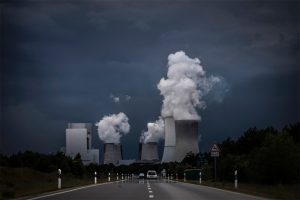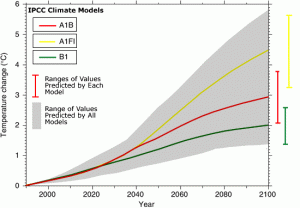Sep 21 2017
New Wrinkle in the Climate Debate
 No matter what happens, it’s part of the conspiracy, at least in the perspective of the conspiracy theorist.
No matter what happens, it’s part of the conspiracy, at least in the perspective of the conspiracy theorist.
But let’s back up a bit. We talking about scientists trying to understand climate change, and specifically the effects of released carbon into the atmosphere. There are a few layers to this question, which is predictably complex.
The first layer is quite basic – sunlight heats up the earth, which radiates some of that heat back out into space as infrared radiation. Carbon dioxide in the atmosphere reflects some of these infrared photons back down to the Earth, trapping some of that heat. This is commonly known as the greenhouse effect, and hence CO2 as a greenhouse gas. The more CO2 there is in the atmosphere the greater this effect, and the warmer the planet.
The far trickier part, however, is to predict exactly how much warming will occur in response to a certain increase in CO2 in the atmosphere. To answer this question climatologists develop complex climate models, which have to consider all the natural variables that affect climate. They then compare the predictions of these models to what has happened and what does happen, and then tweak them.
 The result is not a precise prediction but a range of possible outcomes with a degree of certainty. This is standard procedure in any science dealing with complex systems. You can see in this graph the various models used by the IPCC and the range of possibilities with error bars. All predict warming, and odds are that some average of the various models is the most likely outcome.
The result is not a precise prediction but a range of possible outcomes with a degree of certainty. This is standard procedure in any science dealing with complex systems. You can see in this graph the various models used by the IPCC and the range of possibilities with error bars. All predict warming, and odds are that some average of the various models is the most likely outcome.
A recent study addresses this very issue, and is getting a lot of attention because it favors the lower end of the range of possible outcomes. Published in Nature Geoscience, the authors looked at recent global temperatures and adjusted the climate models to account for this data. When they ran their adjusted models forward they found that the amount of warming will be lower than the average IPCC estimate.
They also calculate how much carbon dioxide the world can emit before we will cross the 1.5°C threshold of warming above pre-industrial levels. That threshold was chosen because that is the goal of the Paris Climate deal, to limit warming to 1.5°C in order to prevent some of the worst outcomes of climate change. With their new models they found that the world could emit three times as much additional CO2 than predicted by previous models before crossing 1.5°C warming. This would make achieving the Paris goal still very difficult, but not impossible. (Some feel the goal was impossible according to other climate models.)
This new study, however, is going through the meat-grinder of analysis by other experts. Critics argue that the authors used a period of time for their analysis, around the turn of the millennium, that was characterized by a flattening of global warming due to other natural climate trends. These other trends obscured the warming due to CO2 release. Further, during this time there was more CO2 going into the ground and the oceans, again hiding the true effect of CO2 release, but this carbon is now in the carbon cycle and will have long term effects on the climate.
In short, they argue that the authors new model is hopelessly flawed, and underestimates warming because they relied on an unusual period of time in the record where other natural trends obscured the real effects of CO2 release.
The authors, however, push back, arguing that they accounted for these factors, which were only minor players in their climate model.
I have no idea who is correct. The experts will have to hash this out, and likely there will need to be further studies and replications to come to a consensus. But keep in mind, this debate is not about whether or not anthropogenic global warming is happening, just about the degree. And all the climatologists involved agree that it is significant and will be bad.
But of course this situation is ripe for exploitation by denialists. This is one of their core strategies – interpret disagreements among scientists about details as if it calls into doubt the more basic points of agreement. Which animal evolved from which? Perhaps evolution did not happen at all. Were five or six million Jews killed in the holocaust? Perhaps the real answer is zero. Will there be 1.5 or 2.0 degrees of warming by the end of the century? Perhaps there won’t be any at all.
Even more interesting is the response of Roy Spencer, one of the few holdout climatologists who denies global warming. He sees this debate all as a deliberate conspiracy.
I suspect there have been years of discussions in e-cigarette vapor-filled back rooms where Empire leaders have been discussing how the increasing disparity between models and observations should be handled. The resulting new paper is part of a grand scheme that Population Bomb author Paul Ehrlich perfected decades ago. I believe the new narrative taking shape is this: “yes, we were wrong, but only in the timing of the coming global warming disaster. It is still going to happen… but now we have time to fix it, before it really, really is too late.”
Essentially he thinks that the climate change “Empire” is worried that people will think there is no point to trying to mitigate climate change because it is already too late. Therefore, imperial disinformation officers decided in secret to soften the predictions so that it is just barely possible to avoid the bad outcomes of climate change if we act right now.
If anyone had any doubts that Roy Spencer is a kook, rather than a serious climate scientist with reasonable objections to the consensus, this article should put those doubts to rest.
This is an excellent example of how the conspiracy narrative is bullet-proof. No matter what happens, even the normal course of scientific debate, it is part of the grand conspiracy.
I certainly hope that these new lower predictions are closer to the truth, but will have to go with whatever the evidence and consensus of expert opinion based on that evidence says. At the end of the day, there is uncertainty in the climate models. There has always been uncertainty, and I don’t think anyone ever argued otherwise. The error bars have always been there. Even the IPCC’s latest report gave their predictions 95% probability, which means a 1 in 20 chance they are wrong.
But we often have to make decisions with imperfect information, which means we have to play the odds. Given the range of predictions and the levels of consensus, it seems reasonable to make policy based upon an average of the various models as probably being close to the actual outcome. Further, as I and others have argued many times before, there are many win-wins that we can do to mitigate CO2 release without making any sacrifices. In fact, they are good ideas even if you don’t believe in global warming.
Replace those incandescent bulbs with LED bulbs – it will save you time and money. For many people going solar will reduce their electricity bill. As a nation we need to update our energy grid anyway, so let’s do it now. Developing grid storage will also be a huge benefit to the stability of the grid and the efficiency of our energy production. And reducing pollution will save billions of dollars in health care costs.
Going to clean renewable energy and an updated infrastructure is a no-brainer. It’s a win-win – it’s not a sacrifice at all, just a good investment. And if we avoid the worst outcomes of global warming at the same time, that’s the icing on the cake.






